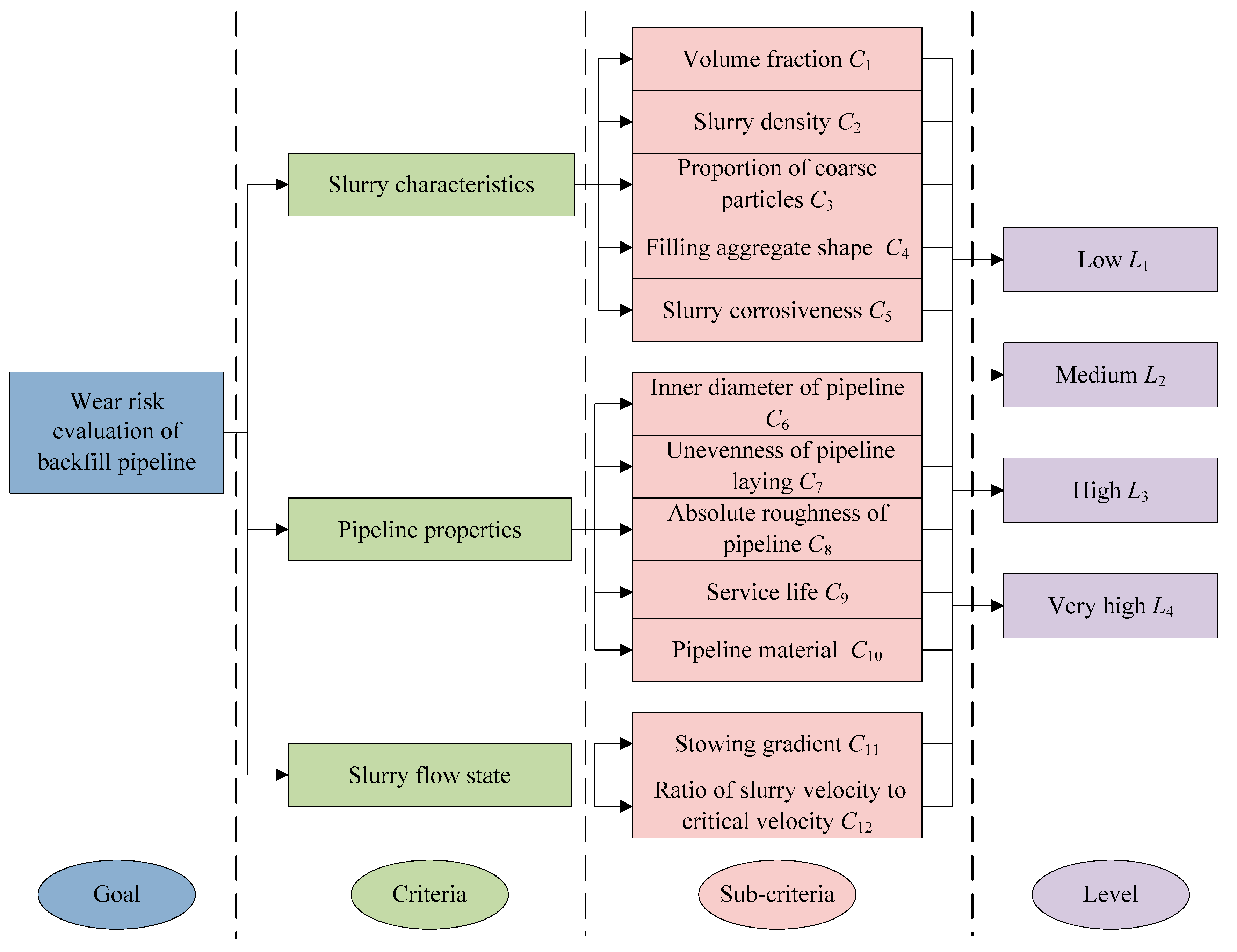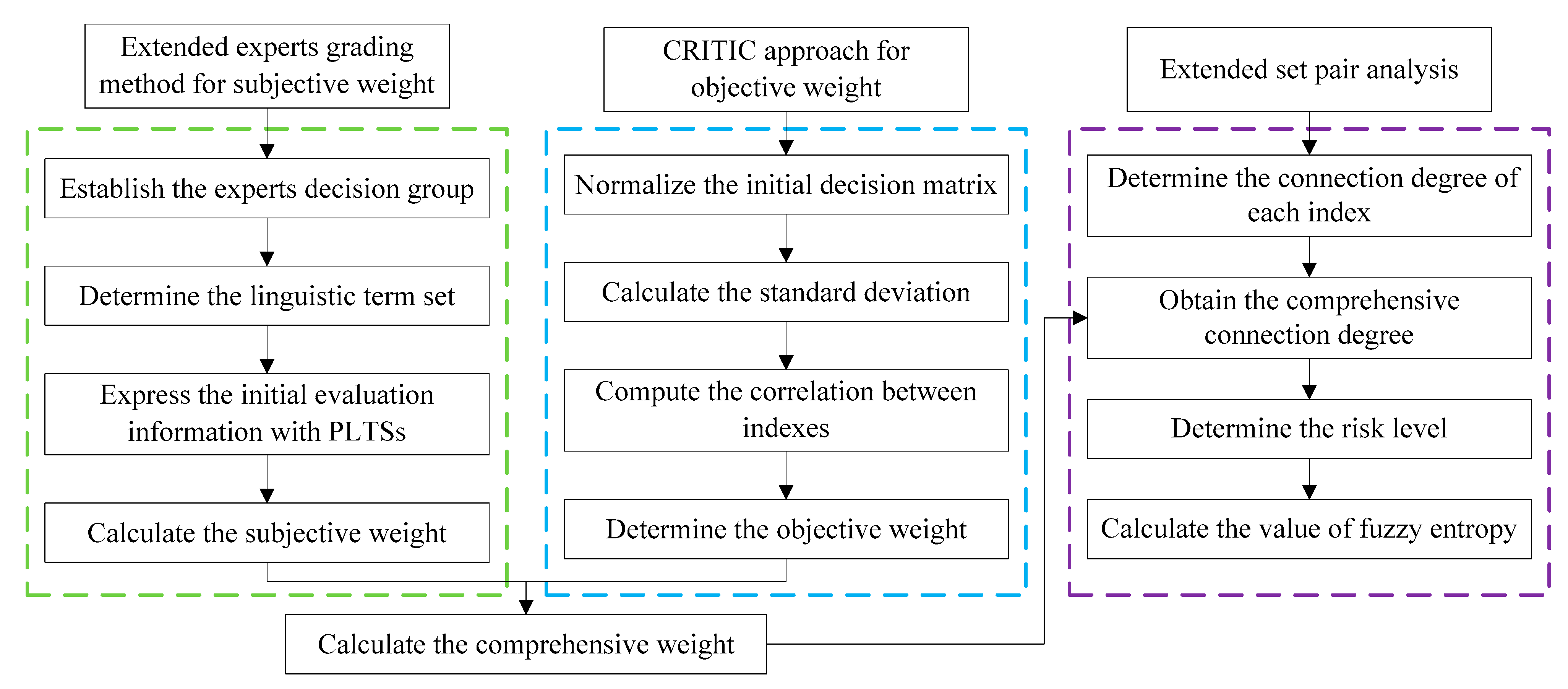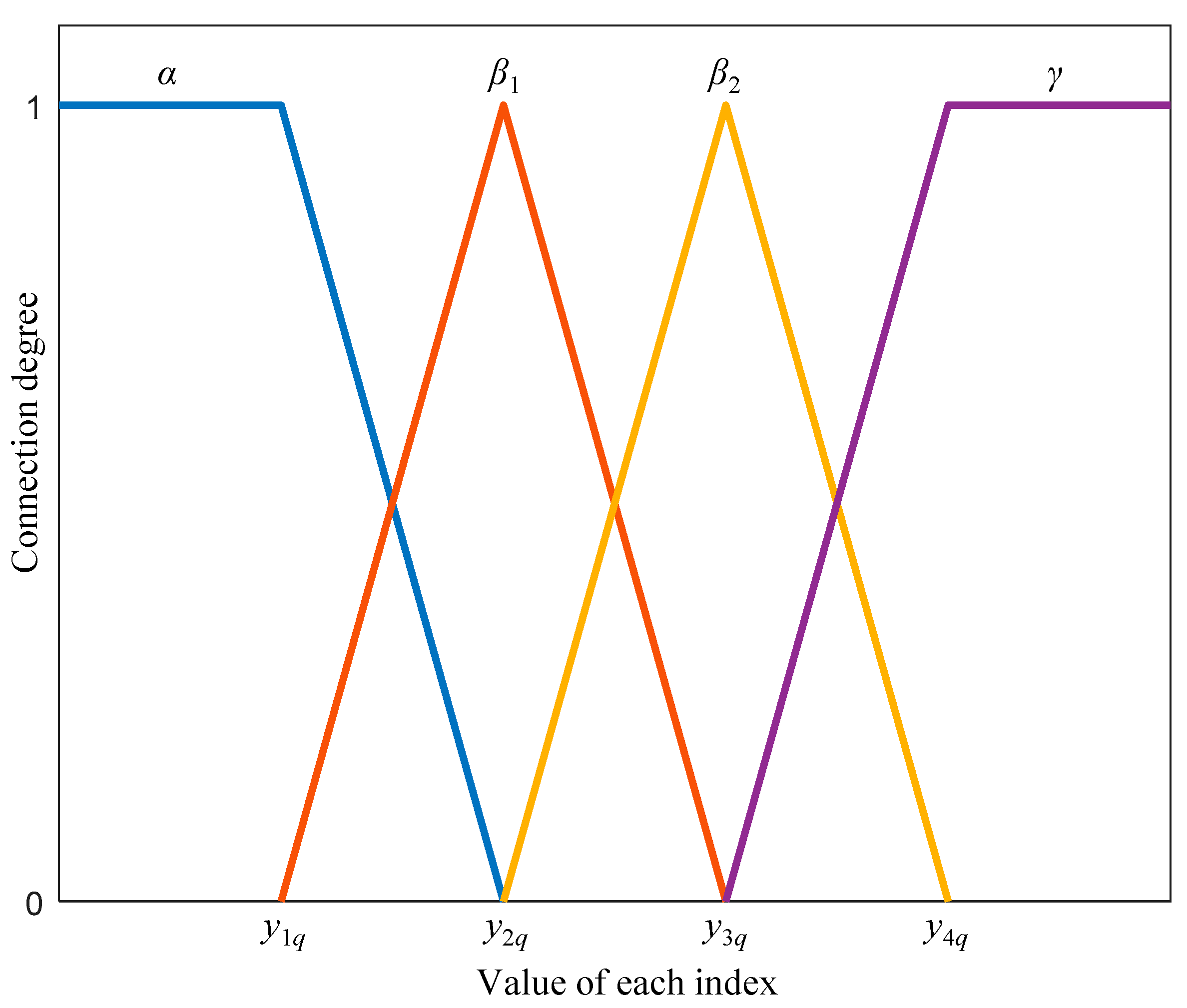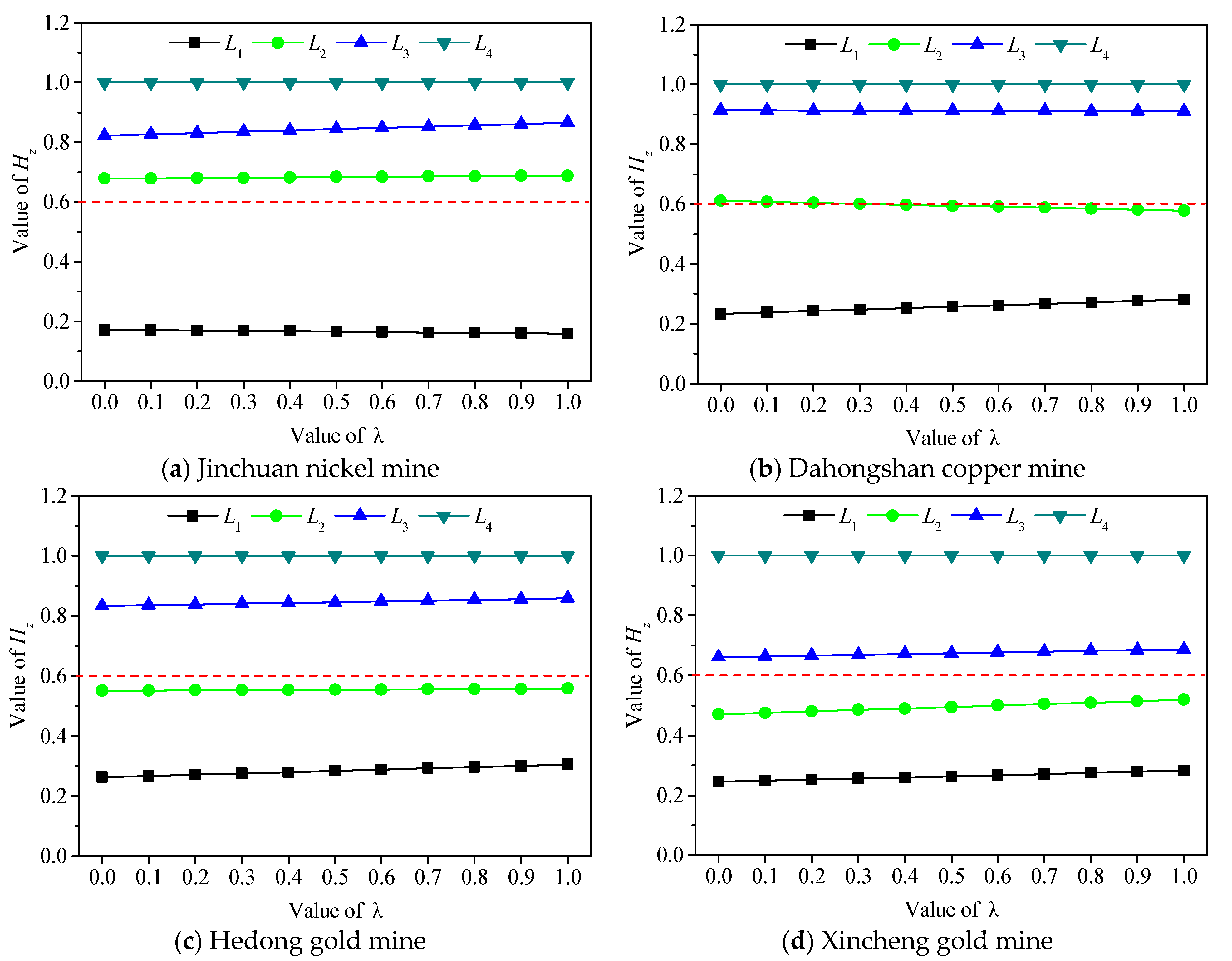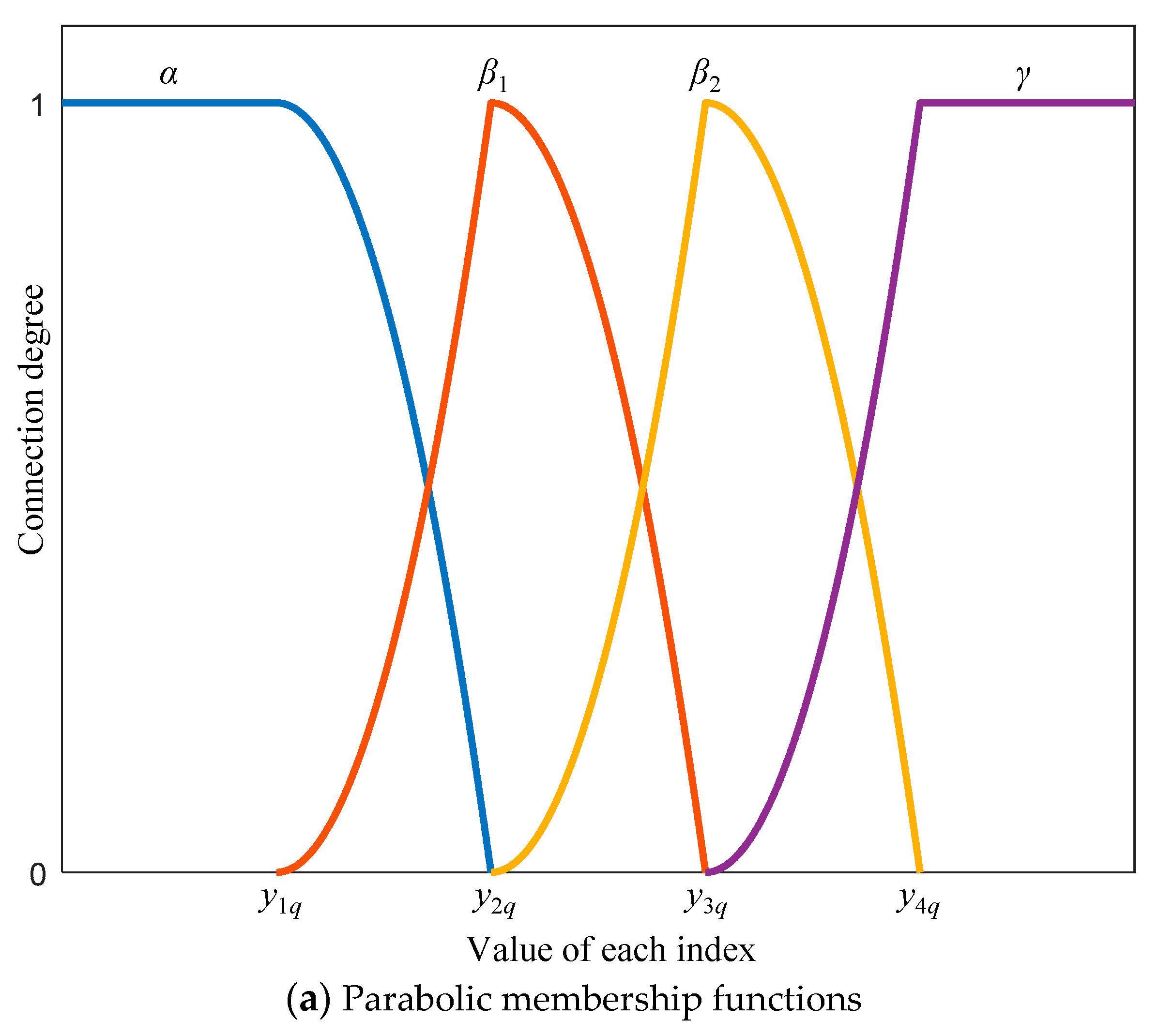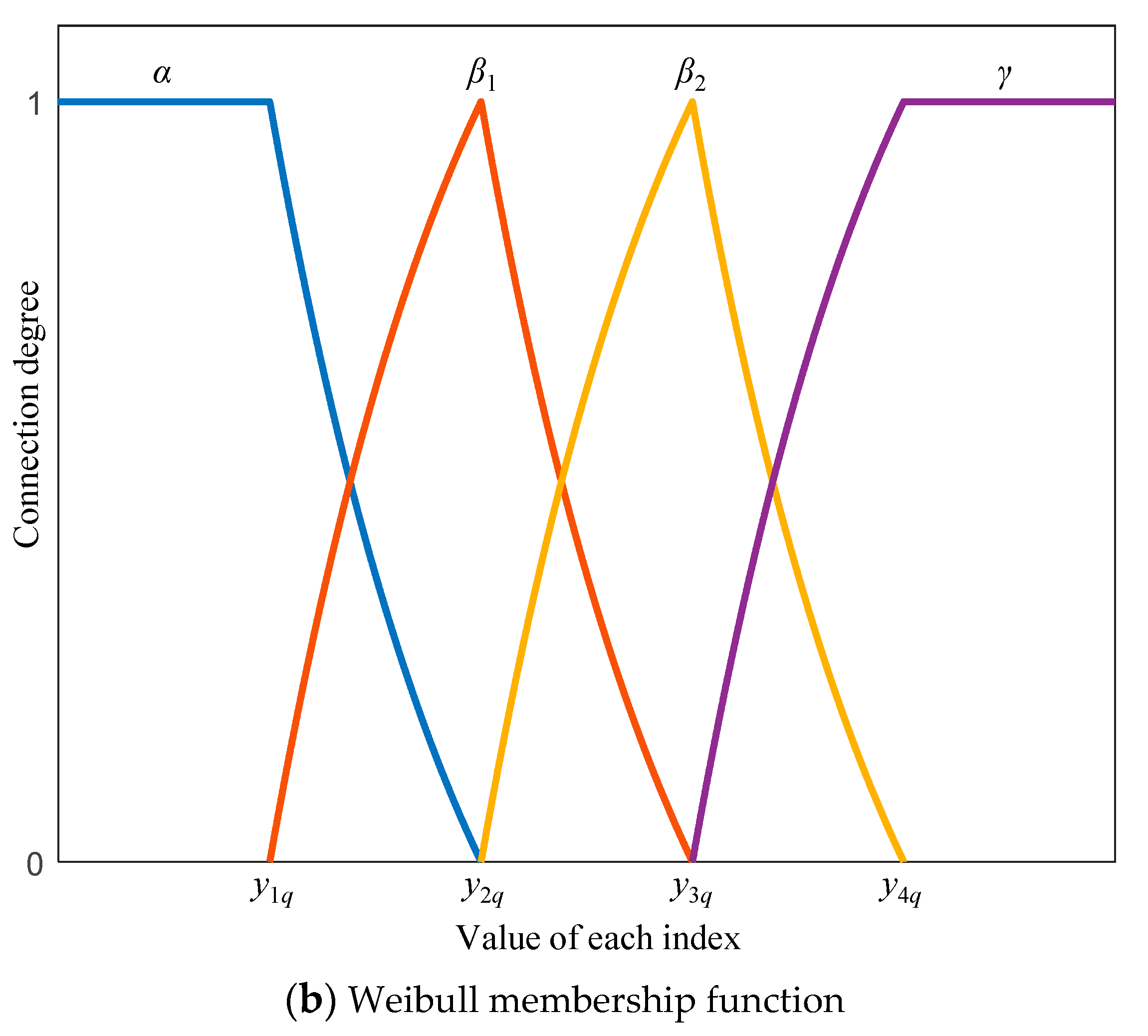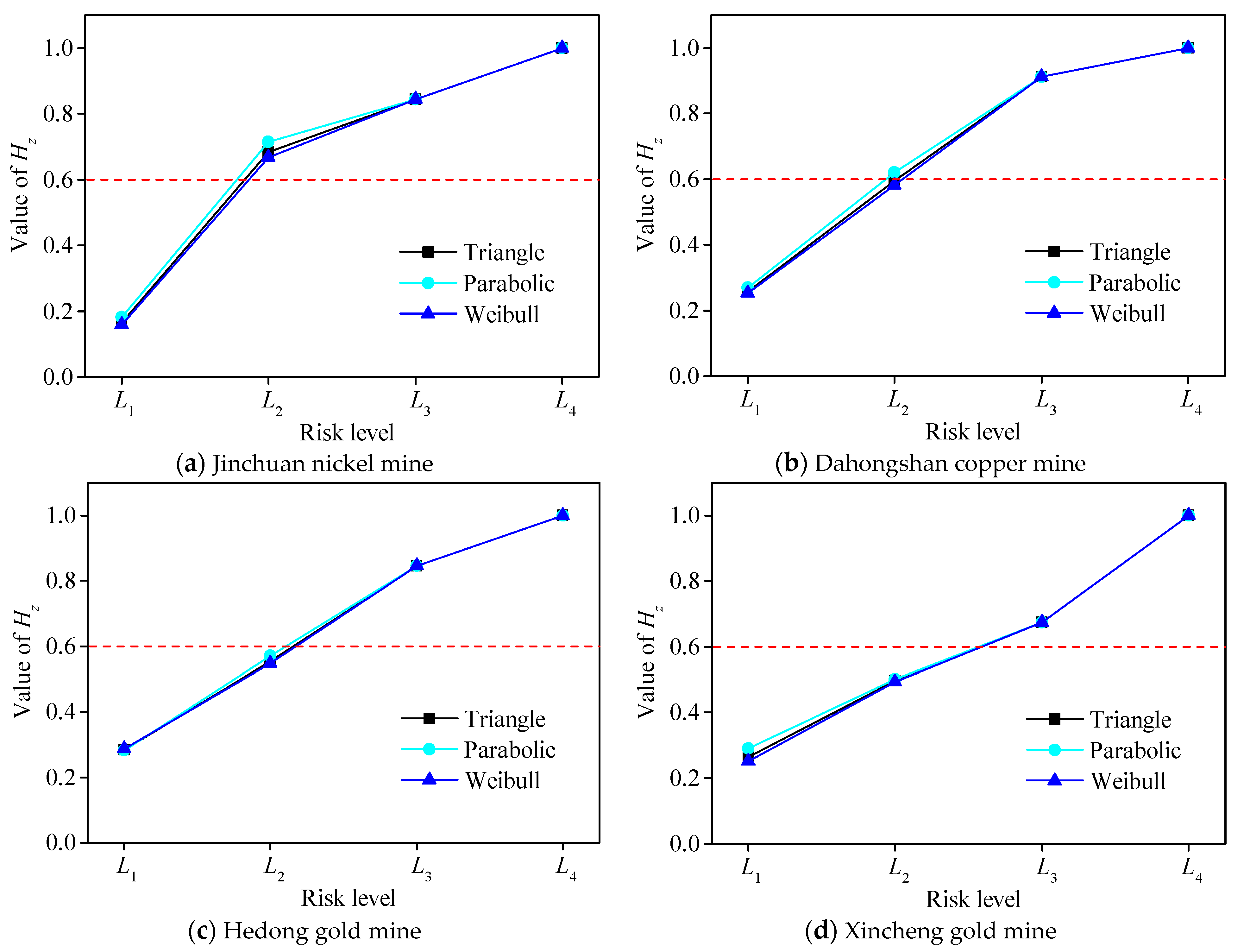1. Introduction
Due to the requirements of safety and environmental protection, the backfill mining method has been widely used in underground mines [
1,
2,
3]. With the increase in mining depth, the safety, stability and reliability of filling systems have become more and more important. The backfill pipeline, which plays the role of transporting filling slurry from surface filling stations to underground stopes, is a key part [
4]. However, the filling slurry can wear and even break the pipeline during long-distance transportations [
5,
6]. It not only affects the normal production and economic benefits of mines, but also may lead to major safety accidents. Then, the sustainability of mines can be greatly affected. Therefore, assessing the wear risk of backfill pipeline is crucial and meaningful for risk management.
Plenty of research has been conducted on the wear characteristics of backfill pipeline. Steward and Spearing [
7] summarized the factors that affected the wear of pipeline. Cooke [
8] deemed that the movement of particles on the pipeline wall included abrasion and erosion, and then classified the wear modes into deformation and cutting wear. McGuinness and Cooke [
9] identified the issues related to the thinning of pipeline walls, which can cause undesirable safety concerns and severe localized wear. Hewitt et al. [
10] determined the relationship between pipe material and wear rate based on the pipe lining abrasion testing, and found that the pipe material was significantly important for the availability of the backfill system. Zhang et al. [
11] analyzed the wear mechanism of vertical backfill pipeline from the perspective of momentum and energy, and deemed that the wear position was in the interface between air and solid-liquid mixture. Gharib et al. [
12] evaluated the flow and wear characteristics in pipe elbows by combining analytical solutions, experimental and numerical simulation methods, and discovered elbow design and slurry property had large influences on pipe wear rate. Wang et al. [
13] invested the wear of backfill pipelines in Jinchuan nickel mine, and summarized the main influencing factors of pipeline wear. Creber et al. [
14] measured the wear rate of backfill pipeline in four Canadian mines, and found the selection of backfill materials can significantly influence wear rate. This research provide foundations for the determination of wear risk evaluation indexes.
Recently, numerous mathematical models have been developed to assess the wear risk of backfill pipeline, which can be summarized into two types. The first one is the machine learning algorithm. Li and Nie [
15] integrated the kernel principal component analysis, particle swarm optimization and generalized regression neural network to tackle wear risk issues of backfill pipeline. Guo and Zhang [
16] adopted the principal component analysis and back propagation neural network to establish backfill pipeline wear risk evaluation models. Luo et al. [
17] introduced an improved particle swarm optimization to optimize the least squares support vector machine for the wear risk prediction of backfill pipeline. These algorithms can well establish the nonlinear relationship between the wear risk level and evaluation indexes, but a large amount of data is required to improve the reliability. The second one is the multi-criteria evaluation approach. Zhang et al. [
18] evaluated the reliability of backfill pipeline based on extenics theory. Xue et al. [
19] selected twelve evaluation indexes, and proposed an integrated model of combination weights and variable fuzzy sets to evaluate backfill pipeline wear risk. Wang et al. [
20] adopted fourteen influencing factors, and used cloud model to predict wear risk of vertical filling pipes. Ding et al. [
21] chose twelve indicators, and established the evaluation model of wear risk based on the improved unascertained measurement method. These approaches can simultaneously consider the influence of qualitative and quantitative indexes, and effectively determine the specific risk levels. However, the index weights and the risk rating standards should be determined in advance.
Except for above methods, set pair analysis (SPA) is another effective quantitative assessment method. Due to the simple calculation steps, objective evaluation results and superiority in dealing with both certainty and uncertainty, it has been widely used in a range of fields. For example, Guo et al. [
22] integrated an improved SPA and variable fuzzy set to assess the risk of flood disaster. Chong et al. [
23] used the analytic hierarchy process, gray model theory, and SPA to deal with occupational hazard problems of coal mining. Roy and Datta [
24] adopted the entropy theory and SPA to achieve adaptive management of coastal aquifers. Giao et al. [
25] classified the water quality in Vietnamese Mekong delta based on SPA and Vietnamese water quality index. Zhang and Li [
26] combined the projection pursuit method and improved SPA to assess the construction risk of deep foundation pit. Zhao et al. [
27] combined analytic hierarchy process, entropy weight method and SPA to identify the source of water inrush. Wang et al. [
28] used combination weighting method and SPA to establish the risk assessment model of airport bird strikes. Considering the effectiveness of SPA has been proved in various studies, it may be suggested to evaluate the wear risk of backfill pipelines. However, two key issues need to be addressed for the classical SPA. One is the determination of connection degree expression, and another one is the judgment of the difference between samples with the same risk level but with different connection numbers. To address these two issues, the membership function in fuzzy theory can be firstly introduced to determine the connection degree [
29]. Thereafter, the fuzzy entropy of connection numbers can be used to reflect the inherent ambiguity of information [
30]. In this case, the sample can be evaluated from the perspectives of both the risk level and complexity.
The aim of this study is to propose an extended SPA for the wear risk evaluation of backfill pipeline. First, the wear risk evaluation index system of backfill pipeline is established. Then, the extended experts grading method with probabilistic linguistic term sets (PLTSs), and criteria importance through intercriteria correlation (CRITIC) approach are combined to calculate the index weights. After that, the SPA is extended to evaluate the wear risk from both the risk level and complexity. Finally, the proposed methodology is applied to assess the wear risk in four mines.
2. Evaluation Indexes of Wear Risk
Selecting appropriate indexes is essential for the wear risk evaluation of backfill pipeline. Due to the complexity of influencing factors, a standard evaluation index system has not been formed. Based on the wear mechanism of backfill pipeline, evaluation indexes are selected from three criteria, including slurry characteristics, pipeline properties, and slurry flow state. The index system for the wear risk evaluation of backfill pipeline is shown in
Figure 1.
- (1)
Slurry characteristics
Since pipeline wear is caused by the friction between the filling slurry and pipeline wall, it is true that the wear risk is related to the slurry characteristics [
7,
31,
32]. In general, the volume fraction, density, proportion of coarse particles, aggregate shape, and corrosiveness of slurry have large influences on pipeline wear. Therefore, the sub-criteria of slurry characteristics include the volume fraction (denoted as
), slurry density (denoted as
), proportion of coarse particles (denoted as
), filling aggregate shape (denoted as
), and slurry corrosiveness (denoted as
). The wear rate of pipeline elevates with the increase in
,
, and
. The more irregular the shape of the filling aggregate, the greater the pipeline wear. In addition, the slurry corrosiveness will accelerate the wear of pipeline.
- (2)
Pipeline properties
Under the same slurry characteristics, the wear is closely related to the properties of the selected pipeline [
7,
33,
34]. The inner diameter, installation quality, absolute roughness, service life, and material affect the pipeline wear greatly. Therefore, the sub-criteria of pipeline properties include the inner diameter of pipeline (denoted as
), unevenness of pipeline laying (denoted as
), absolute roughness of pipeline (denoted as
), service life (denoted as
), and pipeline material (denoted as
). The wear rate of pipeline decreases with the increase in
. The larger the
,
, and
, the lower the pipeline wear. Moreover, the service life of pipeline with wear-resistant lining is several times that of ordinary steel pipeline.
- (3)
Slurry flow state
The wear of pipeline is different when the slurry flow state is dissimilar. The slurry flow state is affected by many factors, such as the stowing gradient and the ratio of slurry velocity to critical velocity [
16,
17,
19]. Stowing gradient indicates the ratio of the total length to the height difference between the start and end of the pipeline. If the stowing gradient is too small, the wear will get worse with the increase in slurry impact force on pipeline. In addition, the greater the ratio of slurry velocity to critical velocity, the more severe the wear. Therefore, the sub-criteria of slurry flow state include the stowing gradient (denoted as
) and the ratio of slurry velocity to critical velocity (denoted as
).
According to the severity of pipeline wear, the risk is classified into four levels, including low (
), medium (
), high (
), and very high (
). To assess pipeline wear risk, the index values corresponding to these four levels are indicated, as shown in
Table 1 [
35]. It can be seen that the index system includes nine quantitative indexes (
,
,
,
,
,
,
,
and
) and three qualitative indexes (
,
and
). To facilitate evaluation, the scores of qualitative indexes for level
,
,
and
are selected as 1, 2, 3, and 4, respectively.
3. Methodology
A novel methodology for the wear risk evaluation of backfill pipeline is proposed in this section. It mainly includes two phases, as shown in
Figure 2. First, the comprehensive weight is calculated based on an extended experts grading method and CRITIC approach. Then, the wear risk of backfill pipeline is determined by the extended SPA. The details of these two phases are described as follows.
3.1. Comprehensive Weight Method
- (1)
Extended experts grading method for subjective weight
The subjective weight is determined based on the extended experts grading method with PLTSs. The specific steps are as follows:
Step 1: Determine the linguistic term set
In reality, experts tend to use linguistic phrases to indicate the importance of indicators [
36,
37]. In this study, the linguistic term set is selected as: very unimportant, unimportant, slightly unimportant, medium, slightly important, important, and very important. In general, the linguistic term set can be denoted by
where
is a linguistic variable, and the number of linguistic variables is
. Particularly,
and
represent the lower and upper limits of linguistic variables, respectively.
Then, the linguistic term set in this study can be indicated as
Step 2: Express the initial evaluation information with PLTSs
Based on the selected linguistic term set, experts can evaluate the importance of each index individually and anonymously. To fully describe the original evaluation information, these linguistic phrases can be expressed by PLTSs [
38]. For example, the probabilistic linguistic term set (PLTS)
indicates 10% experts believe it is slightly unimportant, 30% experts believe it is slightly important, and 60% experts believe it is important.
Step 3: Calculate the subjective weight
Given a linguistic term set
, the PLTS can be indicated as [
39]
where
is the linguistic variable
related to the probabilistic information
, and
is the number of linguistic variables in
.
The score function of
can be determined by [
39]
Then, the subjective weight can be calculated by
where
is the subscript of linguistic term
,
is the indicator number, and
.
- (2)
CRITIC approach for objective weight
The CRITIC approach proposed by Diakoulaki et al. [
40] is used to calculate the objective weight. The weight is determined based on the intrinsic fluctuation information of data. This method adopted the standard deviation and correlation coefficient to reflect the volatility and correlation, respectively. If the standard deviation is larger, and the correlation coefficient is smaller, the weight will be higher. The specific steps are as follows [
41,
42]:
Step 1: Normalize the initial decision matrix
Suppose the initial decision matrix is
where
indicates the value of sample
(
) with respect to index
(
).
To eliminate the influence of dimensions, the initial decision matrix should be normalized by
Step 2: Calculate the standard deviation
where
is the average value of index
for all samples.
Step 3: Compute the correlation between indexes
where
indicates the Pearson correlation coefficient between index
and
.
Step 4: Determine the objective weight
- (3)
Calculate the comprehensive weight
Based on the subjective and objective weights, the comprehensive weight can be obtained by
where
is a preference coefficient. If the importance of subjective and objective weights is equivalent, then
.
3.2. Extended Set Pair Analysis
SPA is a systematic analysis method for dealing with uncertain problems [
43]. The core idea is to regard the certainty and uncertainty of things as a system. In this system, the certainty is divided into identity and contrary, and the uncertainty is called discrepancy. By introducing the concept of connection degree, the uncertainties caused by randomness, ambiguity and incomplete information are indicated uniformly [
25,
26].
Generally, the connection degree of two sets can be expressed by
where
,
and
are the connection numbers, which indicate the degree of identity, discrepancy and contrary, respectively, and
,
is the uncertainty coefficient, and
is the contradictory coefficient.
In addition, based on the developability principle, the connection degree can be extended to meet the needs of actual application
where
represents the different levels of discrepancy degree, and
.
The specific steps of the extended SPA are as follows:
Step 1: Determine the connection degree of each index
The triangle membership function is used to determine the connection degree. For benefit indexes, the expression is
where
,
,
,
, and
indicate the limit values of index
for risk level
,
,
,
, and
, respectively.
For cost indexes, the expression is
For clarity, take
as an example, the connection degree of the cost indexes can be demonstrated in
Figure 3.
Step 2: Obtain the comprehensive connection degree
Based on the connection degrees of all indexes, the comprehensive connection degree can be obtained by
Step 3: Determine the risk level
The confidence criterion is used to determine the risk level, and the formula is
where
is the component of the connection numbers in
, and
indicates the confidence level. If the value of
is larger, the evaluation results will be more conservative.
Step 4: Calculate the value of fuzzy entropy
Considering the connection numbers are different, the details of wear risk are difficult to be fully reflected when only using the risk level. On the basis of SPA, fuzzy entropy theory is introduced to further express the complexity of wear risk. Therefore, the wear risk of backfill pipeline can be comprehensively evaluated from both risk level and complexity. The value of fuzzy entropy can be calculated by [
30]
If the value of connection number for each level is the same, the value of is the largest. It indicates there is equal probability of the risks belonging to each level. In this situation, the evaluation system of wear risk is the most complicated.
Specifically, to facilitate the understanding of the proposed method, a glossary is added in
Table A1 in the
Appendix A.
4. Case Study
To verify the feasibility of the proposed methodology, the samples of backfill pipeline wear in the Jinchuan nickel mine, Dahongshan copper mine, Hedong gold mine, and Xincheng gold mine were collected. The value of each index was shown in
Table 2 [
35]. The specific calculation procedures were as follows:
Phase I: Determine the comprehensive weights of indexes
- (1)
Calculate the subjective weights
First, five experts were invited to provide the evaluation information of each index based on linguistic term set. The evaluation results were indicated in
Table 3. Then, based on Equation (3), the score function values of PLTSs were obtained as:
,
,
,
,
,
,
,
,
,
,
, and
. Last, according to Equation (4), the subjective weights were calculated as:
,
,
,
,
,
,
,
,
,
,
, and
.
- (2)
Compute the objective weights
First, the initial decision matrix was normalized by Equations (5) and (6). Then, based on Equation (7), the standard deviation of each index was calculated as: , , , , , , , , , , , and . According to Equation (8), the correlation between indexes was calculated as: , , , , , , , , , , , and . Finally, by using Equation (9), the objective weights were calculated as: , , , , , , , , , , , and .
- (3)
Determine the comprehensive weights
Assuming , the comprehensive weights were determined based on Equation (10) as: , , , , , , , , , , , and .
Phase II: Assess the wear risk using the extended SPA
- (1)
Calculate the connection degree of indexes
Based on Equations (13) and (14), the connection degree of each index for these four mines was calculated, as shown in
Table 4.
- (2)
Obtain the comprehensive connection degree and the risk level
According to Equation (15), the comprehensive connection degree of each mine was determined, as shown in
Table 5.
Based on Equation (16), the value of
was calculated (See the second to fifth columns in
Table 6). Assuming the confidence level
, the risk level was determined (See the sixth column in
Table 6). It can be seen that the wear risk of Jinchuan nickel mine was medium, and that of Dahongshan copper mine, Hedong gold mine and Xincheng gold mine were high. In addition, the evaluation results of the proposed methodology were compared with those of ordered logistic regression in the original literature [
35]. By using ordered logistic regression approach, the probability of different wear risks was obtained. Then, the risk level corresponding to the maximum probability value was used as the final result. The evaluation results of these four mines were shown in
Table 7. It can be seen that the results of this approach were consistent with those of our method, which demonstrated the effectiveness of the proposed methodology to some extent.
- (3)
Determine the fuzzy entropy
By using Equation (17), the values of fuzzy entropy for these four mines were calculated as: , , , and . Comparing with other mines, the value of fuzzy entropy for Jinchuan nickel mine was the smallest, which indicated that the complexity of wear risk was the lowest in this mine.
6. Conclusions
The filling slurry is transported from the surface to the stope through the pipeline system, which inevitably causes the wear of backfill pipeline. This study proposed an extended SPA to evaluate the wear risk of backfill pipeline. In consideration of the wear mechanism of backfill pipeline, the evaluation index system including nine quantitative indexes and three qualitative indexes was established from the aspects of slurry characteristics, pipeline properties, and slurry flow state. The subjective and objective weights were calculated by the extended experts grading method and CRITIC approach, respectively. Then, they were integrated to determine the comprehensive weight. To evaluate the wear risk of backfill pipeline from both the level and complexity, the classical SPA was extended with membership functions and fuzzy entropy theory. The proposed methodology was applied to assess the wear risk in Jinchuan nickel mine, Dahongshan copper mine, Hedong gold mine, and Xincheng gold mine. Results showed that the evaluation results were effective and reliable. Furthermore, the sensitivity analysis indicated that the preference coefficient of weight only had a slight influence on the evaluation results, which revealed the proposed methodology had great stability and robustness. The comparison analysis demonstrated that the expression of connection degree affected the results to some extent, whereas the degree of influence was relatively small in this study. In addition, the confidence level had a great influence on the evaluation results, which depended on the risk appetite of decision makers.
Notably, the specific risk levels were largely dependent on the grading standards and the acceptable confidence level. In the future, it is meaningful to establish a uniform evaluation index system and grading standards. In addition, the proposed methodology can be adopted to solve some similar risk evaluation problems in other engineering fields, such as geotechnical engineering, civil engineering, and environmental engineering.
